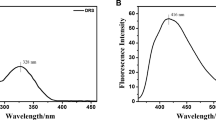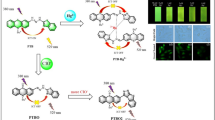Abstract
A reactive fluorescent “turn-on” probe (di-PIP) with imine-linked dual phenanthro[9,10-d]imidazole luminophore have been conveniently prepared as an Al3+ and H+ dual functional receptor. di-PIP displayed high selectivity and sensitivity towards Al3+ ion in DMF/HEPES accompanied by fluorescence blue-shift and a good linear relationship as well as a low detection limit of 30.5 nmol·L–1, which can root from the synergetic functions of the decomposition reaction of di-PIP promoted by acidic Al3+ and the coordination effect between decomposition product and Al3+. Intriguingly, it was found that hydrogen ion H+ can be sufficient for simulating the fluorescence enhancing of di-PIP. 1H NMR titration and MS analyses for elucidation of the intermediate structure further revealed that the acid-triggered decomposition reaction resulted in the rapid, and sensitive sensing to Al3+ and H+. In addition, the probe di-PIP could be successfully applied to the detection of Al3+ in real water samples, and also utilized to visualize Al3+ and H+ in the living cells.









Similar content being viewed by others
Availability of Data and Materials
The data sets supporting the results of this article are included within the article and its additional files.
References
Kaur B, Kaur N, Kumar S (2018) Colorimetric metal ion sensors – A comprehensive review of the years 2011–2016. Coord Chem Rev 358:13–69. https://doi.org/10.1016/j.ccr.2017.12.00208
Lin M, Gong M, Lu B, Wu Y, Wang D, Guan M, Angell M, Chen C, Yang J, Hwang B, Dai H (2015) An ultrafast rechargeable aluminium-ion battery. Nature 520:324–328. https://doi.org/10.1038/nature14340
Ammar J, Khan Z, Ghazi M, Naser N (2021) Synthesis of a new organic probe 4-(4 acetamidophenylazo) pyrogallol for spectrophotometric determination of Bi(III) and Al(III) in pharmaceutical samples. Rev Anal Chem 40:108–126. https://doi.org/10.1515/revac-2021-0125
Manjunath R, Hrishikesan E, Kannan P (2015) A selective colorimetric and fluorescent sensor for Al3+ ion and its application to cellular imaging. Spectrochim Acta Part A: Mol Biomol Spectrosc 140:509–515. https://doi.org/10.1016/j.saa.2015.01.015
Goswami S, Paul S (2013) Abhishek Manna Selective “naked eye” detection of Al(iii) and PPi in aqueous media on a rhodamine–isatin hybrid moiety. RSC Adv 3:10639–10643. https://doi.org/10.1039/c3ra40984h
Woodson G (1998) An interesting case of osteomalacia due to antacid use associated with stainable bone aluminum in a patient with normal renal function. Bone 22:695–698. https://doi.org/10.1016/s8756-3282(98)00060-x
Fasman G (1996) Aluminum and Alzheimer’s disease: model studies. Coord Chem Rev 149:125–165. https://doi.org/10.1016/s0010-8545(96)90020-x
Grady J, Shao J, Arosio P, Santambrogio P, Chasteen N (2000) Vanadyl (IV) binding to mammalian ferritins. An EPR study aided by site-directed mutagenesis. J Inorg Biochem 80:107–113. https://doi.org/10.1016/s0162-0134(00)00046-5
Sakamoto T, Ogasawara Y, Ishii K, Takahashi H, Tanabe S (2004) Accumulation of aluminum in ferritin isolated from rat brain. Neurosci Lett 366:264–267. https://doi.org/10.1016/j.neulet.2004.05.045
Perl D, Brody A (1980) Alzheimer’s disease: X-ray spectrometric evidence of aluminum accumulation in neurofibrillary tangle-bearing neurons. Science 208:297–299. https://doi.org/10.1126/science.7367858
Tavakoli O, Yoshida H (2005) Effective recovery of harmful metal ions from squid wastes using subcritical and supercritical water treatments. Environ Sci Technol 39:2357–2363. https://doi.org/10.1021/es030713s
Nayak P (2002) Aluminum: Impacts and disease. Environ Res 89:101–115. https://doi.org/10.1006/enrs.2002.4352
Lou Z, Li P, Song P, Han K (2013) Ratiometric fluorescence imaging of cellular hypochlorous acid based on heptamethine cyanine dyes. Analyst 138:6291–6295. https://doi.org/10.1039/c3an00198a
Blackburn A, Doe W, Buffinton G (1999) Protein carbonyl formation on mucosal proteins in vitro and in dextran sulfate-induced colitis. Free Radical Biol Med 27:262–270. https://doi.org/10.1016/s0891-5849(99)00065-9
Delhaize E, Ryan P (1995) Aluminum toxicity and tolerance in plants. Plant Physiol 107:315–321. https://doi.org/10.1016/j.sajb.2019.02.008
Yue Y, Huo F, Cheng F, Zhu X, Mafireyi T, Strongin R, Yin C (2019) Functional synthetic probes for selective targeting and multi–analyte detection and imaging. Chem Soc Rev 48:4155–4177. https://doi.org/10.1039/c9cs90059d
Gao P, Pan W, Li N, Tang B (2019) Fluorescent probes for organelle–targeted bioactive species imaging. Chem Sci 10:6035–6071. https://doi.org/10.1039/c9sc01652j
Manivannan R, Son Y (2020) A Pyrene-Tetrazole Fused Fluorescent Probe for Effective Real Time Detection Towards Aluminium Ion. J Fluoresc 262:116334. https://doi.org/10.1007/s10895-022-02985-4
Fan L, Liu K, Yang Z (2022) A novel and reversible multifunction probe for Al3+ and F- by fluorogenic and colorimetric method. J Photoch Photobio A 429:113911. https://doi.org/10.1016/j.jphotochem.2022.113911
Villela A, Vuuren M, Willemen H, Derksen G, Beek T (2019) Photo-stability of a flavonoid dye in presence of aluminium ions. Dyes Pigm 162:222–231. https://doi.org/10.1016/j.dyepig.2018.10.021
Kamaci U, Kamaci M, Peksel A (2021) A dual responsive colorimetric sensor based on polyazomethine and ascorbic acid for the detection of Al (III) and Fe (II) ions. Spectrochim Acta Part A: Mol Biomol Spectrosc 254:119650. https://doi.org/10.1016/j.saa.2021.119650
Erdemir S (2019) Fluorometric dual sensing of Hg2+ and Al3+ by novel triphenylamine appended rhodamine derivative in aqueous media. Sens Actuators B Chem 290:558–564. https://doi.org/10.1016/j.snb.2019.04.037
Imani M, Mohajeri N, Rastegar M, Zarghami N (2021) Recent advances in FRET-based biosensors for biomedical applications. Anal Biochem 630:114323. https://doi.org/10.1016/j.ab.2021.114323
Das A, De S, Das G (2021) Naphthyl-functionalized ninhydrin-derived receptor for ‘CHEF’-based sequential sensing of Al(III) and PPi: Prospective chemosensing applications under physiological conditions. J Photoch Photobio A 418:113442. https://doi.org/10.1016/j.jphotochem.2021.113442
Sun L, Wang X, Shi J, Yang S, Xu L (2021) Kaempferol as an AIE-active natural product probe for selective Al3+ detection in arabidopsis thaliana. Spectrochim Acta Part A: Mol Biomol Spectrosc 245:119303. https://doi.org/10.1016/j.saa.2020.119303
Al-Duais M, Mohammedsaleh Z, Al-Shehri H, Al-Awthan Y, Bani-Atta S, Keshk A, Mustafa S, Althaqafy A, Al-Tweher A, Al-Aoh H, Panneerselvam C (2022) Bovine serum albumin functionalized blue emitting Ti3C2 MXene quantum dots as a sensitive fluorescence probe for Fe3+ ion detection and its toxicity analysis. Luminescence 37:633–641. https://doi.org/10.1002/bio.4204
Zheng Q, Ding F, Hu X, Feng J, Shen J, He X (2021) ESIPT-based fluorescent probe for bioimaging and identification of group Al(III) ions in live cells and zebrafish. Bioorg Chem 109:104746. https://doi.org/10.1016/j.bioorg.2021.104746
Peng S, Wang S, Ding H, Fan C, Liu G, Pu S (2022) A high selective chemosensor for detection of Al3+ based on diarylethene with a hydrazide unit. J Photoch Photobio A 425:113718. https://doi.org/10.1016/j.jphotochem.2021.113718
Janc T, Korb J, Luksic M, Vlachy V, Bryant R, Meriguet G, Malikova N, Rollet A (2021) Multiscale water dynamics on protein surfaces: protein-specific response to surface ions. J Phys Chem B 125:8673–8681. https://doi.org/10.1021/acs.jpcb.1c02513
He C, Lu K, Lin W (2014) Nanoscale metal-organic frameworks for real-time intracellular pH sensing in live cells. J Am Chem Soc 136:12253–12256. https://doi.org/10.1021/ja507333c
Madshus I (1988) Regulation of intracellular pH in eukaryotic cells. Biochem J 250:1–8
Hu J, Wu F, Feng S, Xu J, Xu Z, Chen Y, Tang T, Weng X, Zhou X (2014) A convenient ratiomeric pH probe and its application for monitoring pH change in living cells. Sens Actuat B Chem 196:194–202. https://doi.org/10.1016/j.snb.2014.01.119
Chou P, Luo C, Wali N, Lin W, Ng S, Wang C, Zhao M, Lin S, Yang S, Liu P, Shie J, Wei T (2022) A chemical probe inhibitor targeting STAT1 restricts cancer stem cell traits and angiogenesis in colorectal cancer. J Biomed Sci 29:20. https://doi.org/10.1186/s12929-022-00803-4
Koga N, Tanioka M, Kamino S, Sawada D (2021) Morpholine-substituted rhodamine analogue with multi-configurational switches for optical sensing of pH gradient under extreme acidic environments. Chem Eur J 27:3761–3765. https://doi.org/10.1002/chem.202004254
Wan S, Xia S, Medford J, Durocher E, Steenwinkel T, Rule L, Zhang Y, Luck R, Werner T, Liu H (2021) A ratiometric near-infrared fluorescent probe based on a novel reactive cyanine platform for mitochondrial pH detection. J Mater Chem B 9:5150–5161. https://doi.org/10.1039/d1tb00643f
Zhao B, Zhou Y, Fan M, Li Z, Wang L, Deng Q (2013) Synthesis, fluorescence properties and selective Cr(III) recognition of tetraaryl imidazole derivatives bearing thiazole group. Chin Chem Lett 24:257–259. https://doi.org/10.1016/j.cclet.2013.01.031
Li S, Kan W, Zhao B, Liu T, Fang Y, Bai L, Wang L (2018) A fluorescent pH probe for an aqueous solution composed of 7-hydroxycoumarin, Schiff base and phenanthro[9,10-d]imidazole moieties (PICO). Heterocycl Commun 24:93–97. https://doi.org/10.1515/hc-2017-0174
Firoj A, Anila H, Nandaraj T, Devraj G, Samit C, Amitava D (2016) Specific receptor for hydrazine: mapping the in situ release of hydrazine in live cells and in an in vitro enzymatic assay. Chem Commun 52:6166–6169. https://doi.org/10.1039/c6cc01787h
Si M, Zhu W, Zhang Y, Barboiu M, Chen J (2020) Fluorodynamers displaying tunable fluorescence on constitutional exchanges in solution and at solid film–solution interface. Chem Eur J 26:10191–10194. https://doi.org/10.1002/chem.202000981
Zhang R, Gao M, Bai S, Liu B (2015) A fluorescent light-up platform with “AIE + ESIPT” characteristics for multi-target detection both in solution and on paper strip. J Mater Chem B 3:1590–1596. https://doi.org/10.1039/c4tb01937g
Yuan Y, Wang D, Long W, Deng F, Yu S, Tian J, Ouyang H, Lin S, Zhang X, Wei Y (2021) Ratiometric fluorescent detection of hypochlorite in aqueous solution and living cells using an ionic probe with aggregation-induced emission feature. Sens Actuators B Chem 330:1–8. https://doi.org/10.1016/j.snb.2020.129324
Zhang S, Gu Y, Shi Z, Lu N, Xu H (2021) A novel reversible fluorescent probe based on naphthalimide for sequential detection of aluminum (Al3+) and fluoride (F-) ions and its applications. Anal Methods 13:5360–5368. https://doi.org/10.1039/d1ay01545a
Zhang S, Wang Y, Xu H (2022) A new naphthalimide-picolinohydrazide derived fluorescent ‘‘turn-on” probe for hypersensitive detection of Al3+ ions and applications of real water analysis and bio-imaging. Spectrochim. Acta Part A: Mol Biomol Spectrosc 275:121193. https://doi.org/10.1016/j.saa.2022.121193
Acknowledgements
The work was supported by the National Natural Science Foundation of China (21978140 and 21506106), the Natural Science Foundation of Heilongjiang Province (GZ20210064) and the Qiqihar University Graduate Innovative Scientific Research Project, China (YJSCX2021005). The authors also gratefully acknowledge the financial support by the Heilongjiang Provincial Key Laboratory of Surface Active Agent and Auxiliary (BMHXJKF004 and BMHXJKF005).
Funding
The work was supported by the National Natural Science Foundation of China (21978140 and 21506106), the Natural Science Foundation of Heilongjiang Province (GZ20210064) and the Qiqihar University Graduate Innovative Scientific Research Project, China (YJSCX2021005).
Author information
Authors and Affiliations
Contributions
Bing Zhao, Wei Kan, Liyan Wang, Bo Song, and Limin Ding contributed significantly to write the manuscript and perform the analysis with constructive discussions; Zhigang Li, Fanqiang Bu, and Xin Qi performed the experiments and the data analyses.
Corresponding authors
Ethics declarations
Ethics Approval and Consent to Participate
Not applicable.
Consent for Publication
Manuscript is approved by all authors for publication.
Competing Interests
The authors declare that they have no conflict of interest.
Additional information
Publisher's Note
Springer Nature remains neutral with regard to jurisdictional claims in published maps and institutional affiliations.
Supplementary Information
Below is the link to the electronic supplementary material.
Rights and permissions
Springer Nature or its licensor (e.g. a society or other partner) holds exclusive rights to this article under a publishing agreement with the author(s) or other rightsholder(s); author self-archiving of the accepted manuscript version of this article is solely governed by the terms of such publishing agreement and applicable law.
About this article
Cite this article
Li, Z., Zhao, B., Kan, W. et al. An Acid-triggered Reactive and Enhanced Fluorescent Probe for Selective Detection of Al3+/H+ and its Application in Real Water Samples and Living Cells. J Fluoresc 33, 91–101 (2023). https://doi.org/10.1007/s10895-022-03039-5
Received:
Accepted:
Published:
Issue Date:
DOI: https://doi.org/10.1007/s10895-022-03039-5




